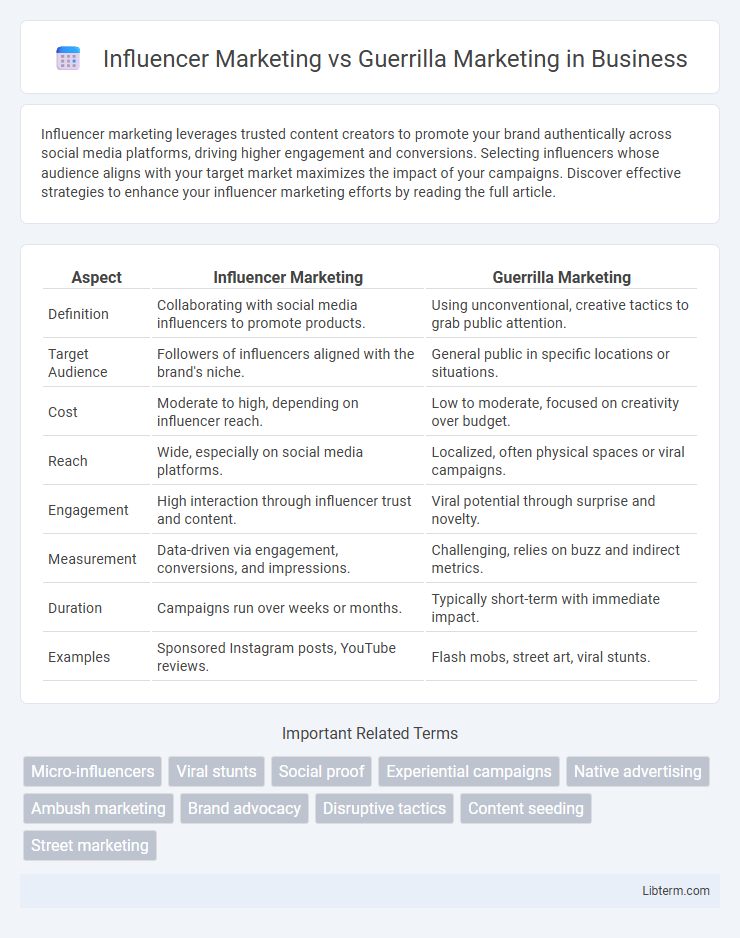Influencer marketing leverages trusted content creators to promote your brand authentically across social media platforms, driving higher engagement and conversions. Selecting influencers whose audience aligns with your target market maximizes the impact of your campaigns. Discover effective strategies to enhance your influencer marketing efforts by reading the full article.
Table of Comparison
| Aspect | Influencer Marketing | Guerrilla Marketing |
|---|---|---|
| Definition | Collaborating with social media influencers to promote products. | Using unconventional, creative tactics to grab public attention. |
| Target Audience | Followers of influencers aligned with the brand's niche. | General public in specific locations or situations. |
| Cost | Moderate to high, depending on influencer reach. | Low to moderate, focused on creativity over budget. |
| Reach | Wide, especially on social media platforms. | Localized, often physical spaces or viral campaigns. |
| Engagement | High interaction through influencer trust and content. | Viral potential through surprise and novelty. |
| Measurement | Data-driven via engagement, conversions, and impressions. | Challenging, relies on buzz and indirect metrics. |
| Duration | Campaigns run over weeks or months. | Typically short-term with immediate impact. |
| Examples | Sponsored Instagram posts, YouTube reviews. | Flash mobs, street art, viral stunts. |
Introduction to Influencer Marketing and Guerrilla Marketing
Influencer marketing leverages social media personalities and content creators to promote products by capitalizing on their established trust and audience engagement, resulting in authentic brand endorsements. Guerrilla marketing employs unconventional, creative tactics in public spaces to generate high-impact, memorable impressions that maximize brand visibility on a limited budget. Both strategies aim to increase brand awareness but differ significantly in execution and target audience interaction.
Core Principles of Influencer Marketing
Influencer marketing leverages trusted individuals with established audience credibility to promote products and services, focusing on authenticity and engagement to drive consumer behavior. Core principles include targeting niche audiences, creating relatable content, and fostering long-term relationships between brands and influencers. This strategy emphasizes measurable impact through social proof and influencer authority, contrasting guerrilla marketing's unconventional, high-impact tactics aimed at rapid brand awareness.
Fundamentals of Guerrilla Marketing
Guerrilla marketing emphasizes unconventional, low-cost strategies that leverage creativity and surprise to capture consumer attention in public spaces. It relies on high-impact, memorable experiences that engage the audience directly, often through street art, flash mobs, or viral stunts. Unlike influencer marketing, which depends on social media personalities to promote brands, guerrilla marketing focuses on innovative physical interactions to create strong emotional connections and word-of-mouth promotion.
Key Differences Between Influencer and Guerrilla Strategies
Influencer marketing leverages social media personalities with established audiences to promote brands through authentic content, emphasizing trust and engagement. Guerrilla marketing relies on unconventional, low-cost tactics such as street art or flash mobs to create memorable, high-impact consumer experiences in public spaces. The key difference lies in influencer marketing's focus on digital relationships and credibility versus guerrilla marketing's emphasis on surprise, creativity, and offline interaction to generate buzz.
Audience Targeting: Influencer vs Guerrilla Approaches
Influencer marketing targets niche audiences through trusted personalities on platforms like Instagram, TikTok, and YouTube, offering precise demographic alignment and higher engagement rates. Guerrilla marketing relies on unconventional, often offline tactics to capture broad, diverse audiences with memorable, viral experiences in public spaces. The influencer approach excels in targeting specific consumer segments, while guerrilla marketing thrives on creating wide-reaching brand awareness through surprise and creativity.
Cost and ROI Comparison
Influencer marketing typically involves costs related to influencer fees, content creation, and platform promotion, which can vary widely depending on the influencer's reach and niche, but often yields measurable ROI through targeted audience engagement and conversions. Guerrilla marketing, on the other hand, relies on low-budget, unconventional campaigns designed to maximize impact with minimal spend, often delivering high ROI due to its creativity and viral potential, though tracking precise returns can be challenging. Brands seeking cost-effective strategies with quantifiable ROI may prefer influencer marketing, while those aiming for memorable, disruptive brand exposure may opt for guerrilla marketing despite less predictable financial outcomes.
Brand Awareness and Engagement Impact
Influencer marketing leverages popular social media personalities to enhance brand awareness by tapping into their established follower base, resulting in high engagement through authentic content and targeted messaging. Guerrilla marketing relies on unconventional, creative tactics that capture public attention and provoke strong emotional responses, fostering memorable brand experiences that boost engagement and word-of-mouth promotion. Both strategies effectively increase brand visibility, with influencer marketing excelling in digital reach and guerrilla marketing driving local, experiential impact.
Case Studies: Influencer Marketing Success Stories
Influencer marketing campaigns such as Daniel Wellington's strategic collaborations with micro-influencers led to a 15% increase in brand awareness and a 200% growth in sales within a year. Another case is the Fenty Beauty launch, where Rihanna's direct engagement with influencers generated over $72 million in earned media value. These examples demonstrate influencer marketing's effectiveness in targeting niche audiences and driving measurable ROI.
Case Studies: Guerrilla Marketing in Action
The success of guerrilla marketing campaigns is exemplified by case studies such as the Red Bull "Stratos Jump," which generated massive global media coverage and brand engagement through a high-impact, unconventional stunt. Another notable example includes the "Fearless Girl" statue by State Street Global Advisors, which sparked widespread social media conversations and public interest, highlighting the power of guerrilla tactics in creating memorable brand moments. These case studies demonstrate how guerrilla marketing leverages creativity and surprise to achieve extensive audience reach without the significant costs commonly associated with traditional influencer marketing.
Choosing the Right Strategy for Your Brand
Choosing the right strategy for your brand involves analyzing target audience engagement and budget constraints between influencer marketing and guerrilla marketing. Influencer marketing leverages social media personalities to build trust and reach specific demographics, ideal for brands seeking measurable ROI and wide digital exposure. Guerrilla marketing relies on unconventional, creative tactics to generate buzz and local attention, best suited for brands aiming for high-impact, memorable experiences with limited resources.
Influencer Marketing Infographic

 libterm.com
libterm.com